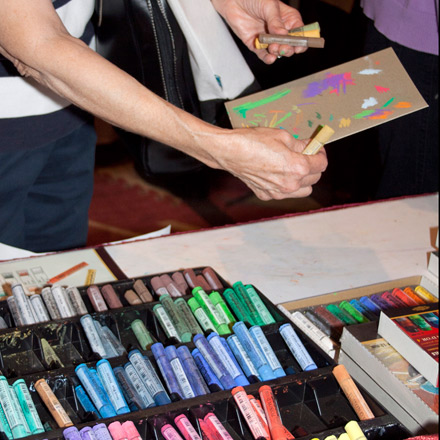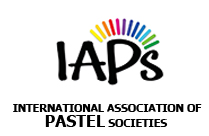
The Pastel Medium
WHAT IS PASTEL?
Pastel is pure pigment, the same pigment used in all art media. When properly framed, it is the most permanent of all when applied to archival ground. Pastel has no liquid binder that may cause the surface to darken, fade, yellow, crack or blister with time. No other medium has the power of color or stability of pastel. It does not oxidize with the passage of time.
 A particle of pastel pigment seen under a microscope looks like a diamond with many facets; therefore, pastel paintings reflect light like a prism. Pastel does not refer to pale colors, as the word is commonly used in cosmetic and fashion terminology. The name “pastel” comes from the French word “pastiche,” because the pure, powdered pigment is ground into a paste with a binder and then rolled into sticks.
A particle of pastel pigment seen under a microscope looks like a diamond with many facets; therefore, pastel paintings reflect light like a prism. Pastel does not refer to pale colors, as the word is commonly used in cosmetic and fashion terminology. The name “pastel” comes from the French word “pastiche,” because the pure, powdered pigment is ground into a paste with a binder and then rolled into sticks.
An artwork is created by striking the sticks of dry pigment across an abrasive ground, embedding the color in the “tooth” of the paper, sanded board, canvas, etc. If the round is completely covered with pastel, the work is considered a pastel painting; leaving much of the ground exposed produces a pastel sketch. Techniques vary with individual artists. Pastel can be blended or used with visible strokes. The medium is favored by many artists because it allows a spontaneous approach. There is no drying time, and no allowances have to be made for a change in color due to drying.
The presence of pastel has been identified in works of art from about 1500 A.D. The practice of drawing became enormously popular in the 15th century. Leonardo, the most prominent proponent of this art form, is credited with the first known use of pastel in his portrait of Isabella D’Este (1499), a preparatory drawing in black and red chalk with traces of yellow pastel in the sitter’s hair and necklace. A century later it was recorded that Leonardo practiced “a pastello.”
Venetian artist Rosalba Carriera (1664–1754) transformed pastel painting into an autonomous independent art form. She created compelling portraits of the artistocracy, whose penchant for powdered accoutrement and make-up suited the dry friable nature of the medium. Quentin Maurice de la Tour and other pastelists perpetuated a highly blended technique in portraiture. However, Chardin, as well as artists later in the 18th and 19th centuries, used visible open strokes. Delacroix, Renoir, Degas, Cassatt, Whistler, Hassam and Chase were among the many who employed combinations of techniques, broadening the pictorial subject matter in pastel.
Today, pastel paintings enjoy the stature of oil and watercolor as a major fine art medium. The Metropolitan Museum of Art’s acquisition, “Gustavus Ham, Hon. Viscount Boyne in Masquerade Costume” (1710–1746), a stunning portrait by Rosalba Carriera, hangs amidst the splendor of period furniture and decorative arts. One of Degas’ most fascinating pastels, “Au Musée Du Louvre (Miss Cassatt),” was sold at Sotheby’s for $16.5 million.
Note: Pastel has sometimes been referred to as chalk. In fact, the use of chalk predated the use of pastel as a medium. The range of colors (from soft and subtle to strong and brilliant) and the smoothness of application of manufactured pastels are vastly different from the dyes and binders characteristic of fabricated synthetic chalks.
Reprinted from the program of the Thirty-Fifth Annual Open Juried Exhibition, For Pastels Only, 2007, with permission of the Pastel Society of America.
